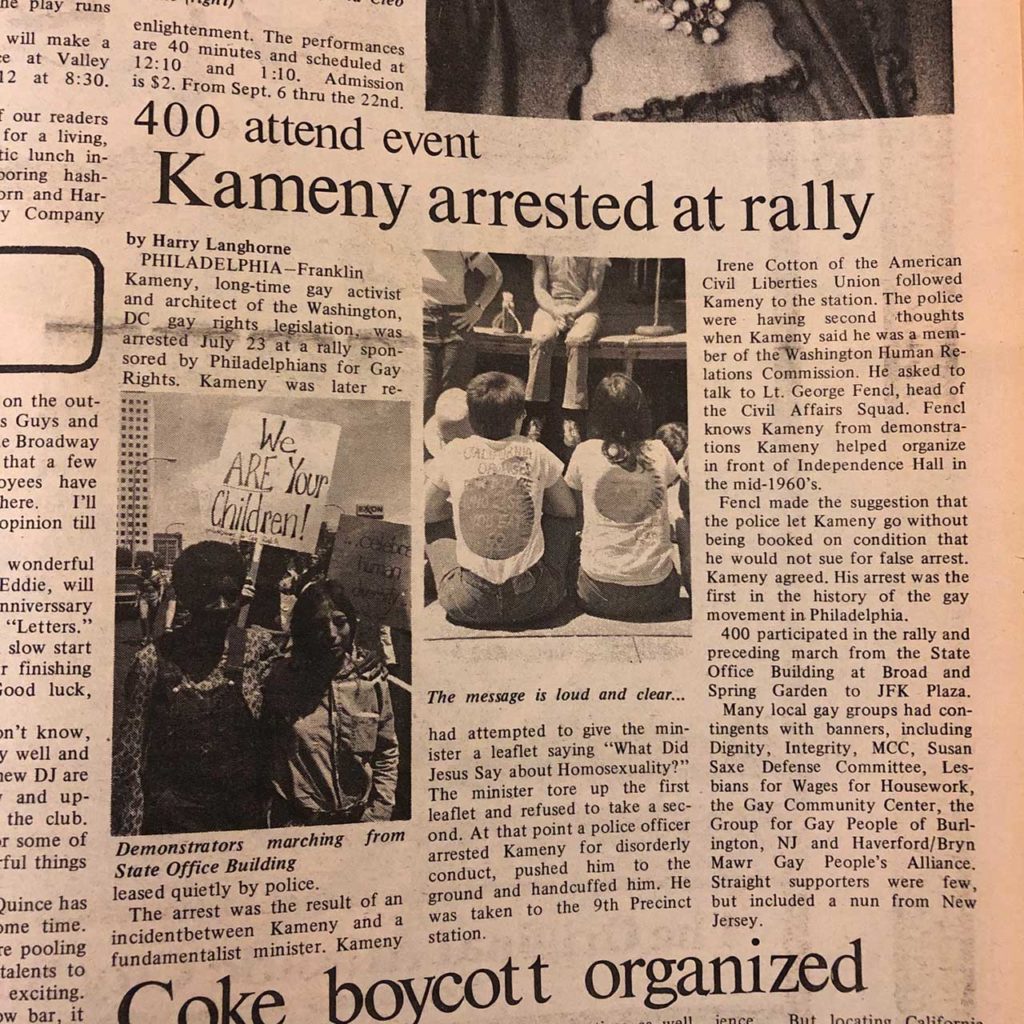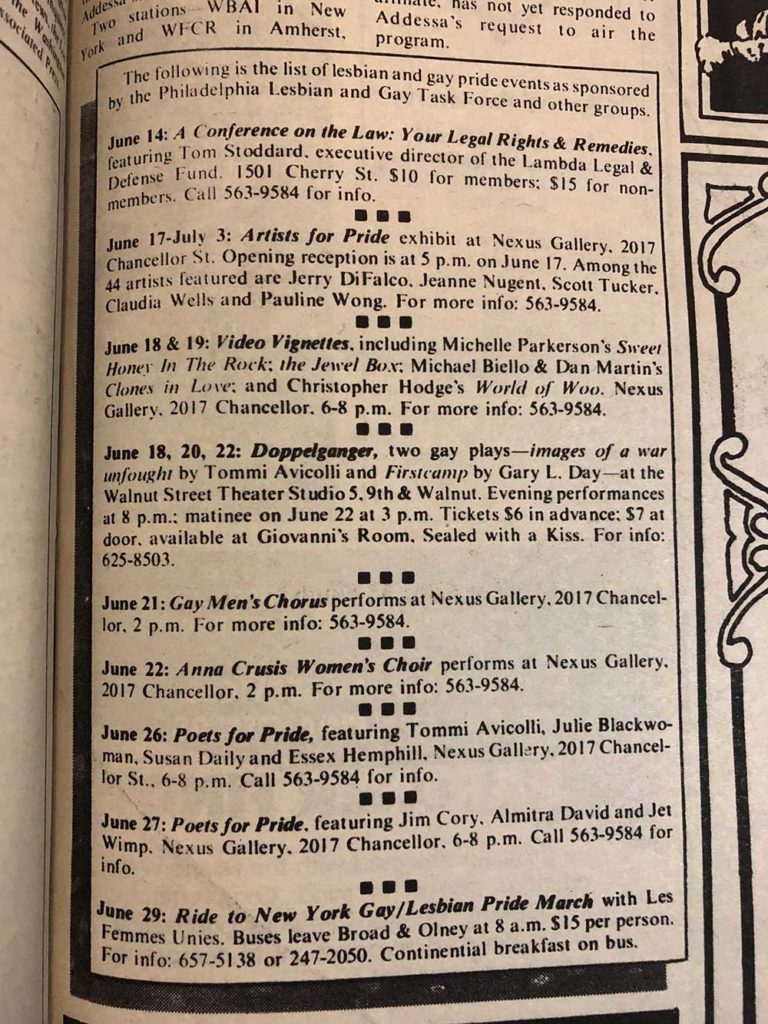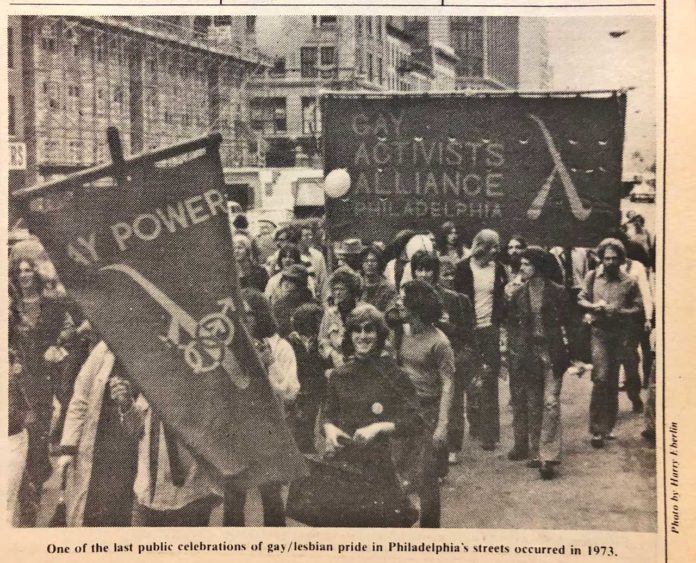The first Gay Pride Parade in Philadelphia took place in 1972, running from Rittenhouse Square to Independence Park. Three years after Stonewall, Philadelphia had its own pride day celebration, and the event continued in that format through 1976. Since its inception that same year, PGN has reported on the various pride parades and rallies in Philadelphia. Here is a year-by-year look back at the beginnings of our city’s pride celebrations as reported in the paper.
1976: The Mummers band led the parade, which began and ended at Rittenhouse Square. After the parade, the crowd remained to hear speeches from Leonard Matlovich, Reverend Freda Smith, Shirley Segal, the mother of PGN publisher Mark Segal, and the mother of PGN staffer Bill Haught. Mrs. Haught said: “It’s time that the parents of gays came out of the closet and supported their children.” Mark Segal read a proclamation from Gov. Milton Shapp that proclaimed Gay Pride Month in Pennsylvania. It was the first statewide proclamation for Gay Pride Month in the country. The day ended with a pride dance given by Philly’s Metropolitan Community Church.

1977: No official parade took place, but in July, 400 people marched from Broad and Spring Garden Streets to JFK Plaza. The rally was sponsored by the organization Philadelphians for Gay Rights. Notably, pioneer Frank Kameny was arrested during the rally when he tried to hand a pamphlet titled “What Did Jesus Say about Homosexuality?” to a fundamentalist minister. Kameny, who knew members on the Police Civil Affairs Squad, was released quietly without being booked. Kameny’s arrest was the first arrest in the history of the LGBT civil rights movement in Philadelphia.
1978: 300 people attended a “gay pride picnic” at Belmont Plateau. Organizations present included the Walt Whitman Democratic Club and an Interfaith Coalition. Attendees watched Gale Russo pantomimes, ate health foods, and socialized. A German TV producer recorded the event for a documentary.
1979: On the 10th Anniversary of the Stonewall Riots, Philly held a “Stonewall to San Francisco” themed pride celebration at JFK Plaza, including a candlelight vigil for Harvey Milk and PGN staff writer Jan Sergenko, who had committed suicide after being the victim of a group rape. The 500-person event featured free childcare as well as sign language interpreters. Speakers included activists Karla Jay and Allen Young, and the LGBT Catholic group Dignity led the crowd in prayer. People were encouraged to bring their own refreshments. Governor Dick Thornburgh signed a state proclamation for Pride Week, but Mayor Frank Rizzo refused to issue one from the City. Rizzo’s spokesman said the event did not “promote the City or its inhabitants.”
1980: No parade or celebration was held in Philadelphia. According to a short article by PGN staff, “None of Philly’s many gay groups could agree among themselves: none of our “leaders” want to lead…so, this year, Philadelphia’s Gay Pride Day will be held in Atlantic City.” Atlantic City celebrated pride in the form of a block party on Snake Alley.
1981: In May, the PGN put out a call for organizers for Philadelphia Gay Pride ‘81, but there was no substantive response. No official celebration took place in Philadelphia. PGN reported on several groups that chartered buses from Philadelphia to New York Pride. The buses were often sponsored by local bars and clubs.
1982: A Lesbian/Gay Pride Fair took place on July 10 in Tanney Park (24th and Spruce Streets). Organized by the Gay and Lesbian Pride Committee, the event was sparsely attended, and many groups who purchased booth space did not show up.
1983: Like the previous three years, there was no official pride parade. Several articles in the 1983 Pride issue of PGN commented about how issues including proximity to New York had muted desire for a Philadelphia parade. There were other Philadelphia events during Pride Month, including a 10-year anniversary celebration for the many local LGBT organizations that formed after Philly’s first pride in 1972.
1984: No parade or rally, but events included a slideshow on gay history by PGN staffer Tommi Avicolli Mecca, a lesbian and gay film festival, a chamber music concert by gay and lesbian composers, and a gay and lesbian art exhibition. City Council rejected a bill proclaiming Gay Pride Week in Philadelphia, prompting the Lesbian and Gay Task Force to call for “a visible demonstration of pride,” perhaps setting up the potential for a future parade. Rev. Joseph Gilbert, pastor at Metropolitan Community Church, said “No one can defeat gay pride except gay people themselves.”
1985: The Lesbian and Gay Task Force held a “month of activities” for Gay and Lesbian Pride. Similar to the previous year, events included an Artists For Pride ’85 exhibition (three times larger than the 1984 art event), the local premiere of “Warren,” one of the first plays concerning HIV/AIDS, and public affairs programs on eight different TV and radio stations. Program topics included gay and lesbian youth, mental health, civil rights, and elderly gays and lesbians.

1986: Events were largely similar to previous years, including Artists for Pride and Poets for Pride exhibitions. There was a greater call for all area radio and television stations to air a pride public service announcement. Several stations broadcast the PSA during prime time hours. “Bus Ride to New York March” was featured as one of the events. Mayor Wilson Goode issued a proclamation for Pride Week in Philadelphia, which read in part: “Despite and perhaps because of the devastating reality and impact of AIDS on the lesbian and gay community, it is important to seize these opportunities to celebrate strengths, accomplishments, and contributions.”
1987: Channel 12 WHYY announced a slate of programs to commemorate Pride Month, including a fictional drama of Gertrude Stein, a documentary on gay parenting, and documentaries on Rita Mae Brown and The Life and Times of Harvey Milk. It is believed to be the first time any local TV network sent a release announcing commemoration of Pride Month. The city still did not have a pride parade or rally, but continued many of the events of previous years.
1988: The yearly Pride Arts Festival grew to 22-days and featured a tribute to African-American gay writer James Baldwin, who died earlier in the year. Mayor Goode again issued a gay pride proclamation. Angel Ortiz was the only City Councilperson to defend the proclamation at the regular weekly Council meeting. Francis Rafferty, who vehemently opposed the proclamation in the past, again objected and blamed gay people for the spread of AIDS. As in years past, PGN reported on the many U.S. cities who held pride marches and rallies. Philadelphia was not among them.
1989: Twenty years after Stonewall and 10 years after the last official parade in Philadelphia, the city once again resumed its gay pride parade and rally. At noon on June 18, 1,000 people marched from 10th and Spruce to JFK Plaza. The parade was organized by Robert Rowland and the rally by the Lesbian and Gay Task Force. Bill Wood was named as grand marshal of the parade. Led by the Philadelphia Freedom Band, marchers held signs including “I’m Proud of these Wings, Thatcher,” referring to Councilmember Thatcher Longstreth, an opponent of the parade. A number of people wore pink triangles in honor of gay victims of the Holocaust. Speakers at the rally that followed included Angela Bowen, editor of BlackOut, the newsletter of the National Coalition of Black Lesbians and Gays, and City Councilman Angel Ortiz, who introduced a gay pride resolution in Council and saw it passed for the first time. Later that year, the organization that became Philly Pride Presents was created, and we have had our annual parade and celebration ever since.
